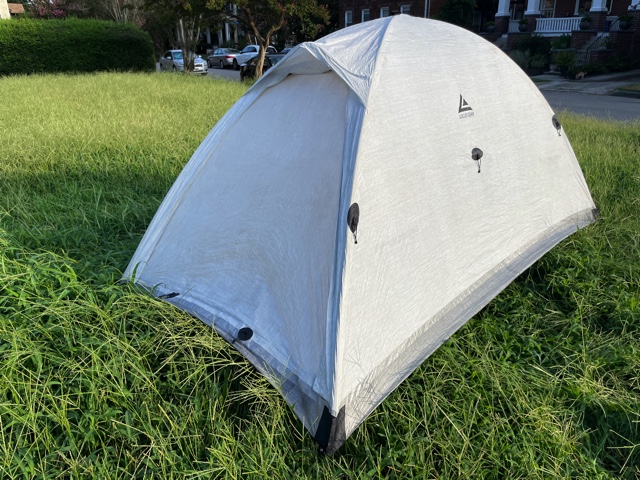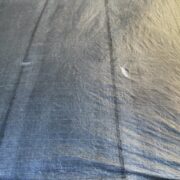I am selling a lightly used Locus Gear Djedi Dome in good condition. I purchased this tent in June, 2020 after seeing it featured in Ryan Jordan’s case study video, “Lightweight Backpacking Gear for Mountain Travel.” Like him, I found the tent to be great from an aesthetic, livability, ease of set up, and functionality perspective.
In addition to the tent body, I am selling both flavors of “vestibule” that Locus Gear has available, the VX and the VT. Both set up with a single trekking pole. The VT is essentially a rain beak while the VX provides a zippered front vestibule that can be completely enclosed.
I purchased the tent and vestibules new from Locus Gear and paid $1294, $317, and $208 for the three components respectively at today’s Japanese Yen to USD conversion rate for a total of $1,819. I am selling the set for over 50% off retail for $900. I will also pay shipping to the continental US or Canada.
I have spent approximately 15 nights in the tent since purchasing it.
The tent has been lightly used and the floor, walls, ground cloth, and mesh are in good shape with the following caveats:
- There are three small holes in the floor that I patched with Tyvek tape in the field and reinforced with the Locus Gear-supplied patch material at home
- There is one pinhole in the supplied silnylon ground cloth that I patched with Tyvek tape in the field
- There is a small hole in the mesh front door near the apex of the entry. I will be patching this with a Gear-aid Tenacious Tape mesh patch
- There are some minor dirt stains on the tent canopy and around the front door but the fabric cleans well and I have taken care to remove everything I personally can see
The pole-set is in like-new condition. I added six interior mesh pockets from ZPacks along the side walls as there was no interior storage.
I am selling the tent *as is.* The attached photos show all of the above to the best of my ability. All items in the photo including stuff sacks, tent body, the two vestibules, patch kit, and ground cloth are included.
I am selling the tent after recently taking it out on a ten-day traverse of the Uinta Highline Trail in August, 2021, and finding that it did not perform well for me in heavy, sustained rain. You can (and should) read a detailed description of the challenges I encountered with the tent in my forum post on the topic.
Others may have better luck than I did in managing condensation and general interior moisture in those conditions. Conversely, the tent is fantastic in the snow, in the wind, and in buggy conditions. Because it is completely freestanding but with excellent guy-outs, it can be pitched just about anywhere as Ryan calls out in his video.
The tent is truly a work of art from a design and fit-and-finish perspective. I will be reverting to a lightweight double-wall shelter for now, however. (I am a fan of both the Nemo Hornet/Hornet Elite 2P, and the Slingfin Portal 2P–all “two person” tents that work great as solo shelters.)
***
Quick notes for full disclosure:
I started with the tent in my backyard in Norfolk, VA during a freezing rain storm and found that even zipped fully shut and with only a small vent at the apex of the front door, the tent seemed to breathe well which was its claim to fame with its DCF+eVent fabric. I also had the tent out on the trail for a two-night trip in very hot and humid mid-summer conditions in the Blue Ridge Mountains where the large mesh door allowed for lots of ventilation. I took the tent out during a colder, windy, but dry three-night outing on some high ridges in the Appalachians. It performed well in all of these conditions. The floor fabric is delicate and I had to patch (first with Tyvek tape which I use in the field, and then reinforced with the DCF tape supplied by Locus Gear) two small holes, along with a pinhole in the very thin ground cloth. I felt confident taking the tent out on the long Uinta Highline hike even given expectations for severe thunderstorms and hail. Unfortunately, we experienced a much different—and by all accounts unusual—weather pattern featuring a long stretch of sustained, heavy, soaking rain. Despite careful pitches of the tent, condensation became an ongoing problem indicating that the tent was not as breathable as my initial outings suggested. And despite impressive hydrostatic pressure ratings for the floor, I found that water seemed able to make it into the tent via the floor itself. I could be misinterpreting the source/cause of the moisture that formed underneath gear I placed on the floor (including my sleeping pad) but my subjective experience is that water was able to penetrate the floor from below.
I am taking pains to be as transparent as possible because this is an expensive tent and I want any buyer to be fully aware of the limitations that I personally encountered. I don’t have enough room in my gear lineup to justify what I would now consider a more specialized piece of gear rather than the robust four-season shelter that I intended this tent to be.













Still available ?
Yes, it’s still available. I just listed it this afternoon. Let me know if you’re interested!
$900 include g & s fees?
I assume you’re asking about Paypal, correct? I don’t have a merchant account since this is the first item I’ve ever sold here. But, yes, I will pay the Paypal G&S fee depending on how we arrange payment.